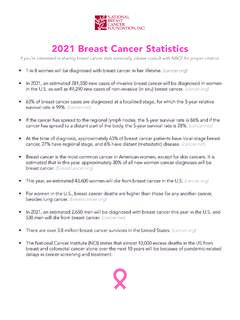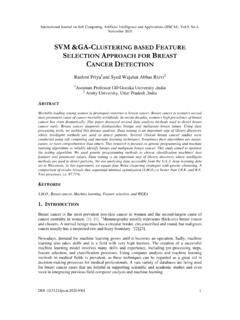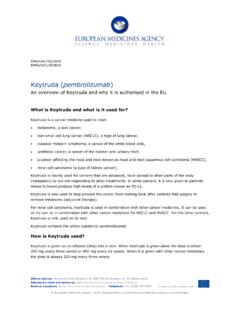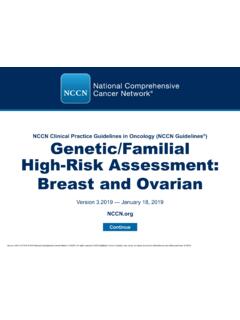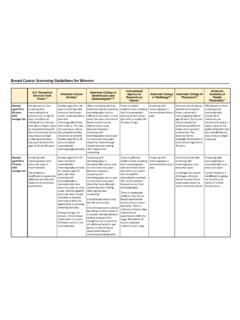Transcription of The New AJCC 8th Edition Breast Cancer Staging
1 The New AJCC 8thEdition Breast Cancer StagingPrognostic Stage Groups & What They MeanMaui, Hawaii 2018 Susan C. Lester, , and Women s HospitalDana Farber Cancer InstituteHarvard Medical SchoolDisclosures My husband is head of translational medicine for the New Indication and Discovery Unit at will not be talking about any Novartis is Cancer Staging Important?For individual patients:Aids in estimating prognosis (survival) for individual patientsBreast cancerStage 0 (DCIS) >97% 20 year survivalStage IV (metastatic) <10% 20 year survivalGuides choices for local and systemic treatmentWhy is Cancer Staging Important?For the health care system and research: Organizes patients into similar groupsEssential for clinical studies, research studies, and epidemiologic studies Important for comparisons by location (country, state, institution), patient groups, and over timeTherefore, it is essential to stage Cancer consistently and accurately for optimal Cancer Denoix, MD (1912-1990)L Institut Gustave RoussyHe pioneered the Tumor Nodes Metastasis classification of was adopted by the Union for International Cancer Control (UICC) in the 1950 was adopted by the American Joint Committee on Cancer (AJCC) and issued their first Edition there were refinements, Breast Cancer Staging remained substantially the same over ~60 historical interlude.
2 M etastasis (distant)~5% of women with Breast Cancer have distant metastases at the time of first diagnosis in the Stage important prognostic factor for these Second most important prognostic factor -60% of women with palpable carcinomas have positive of women with nonpalpable carcinomas have positive Tis Carcinoma in situT1mic to T3 Size of invasive carcinomaT4 Skin and/or chest wall involvement or inflammatory , N, and M are combined to create 5 stages:AJCC/UICC Breast Cancer Stage up to 7thEdition% of patients survivingAnatomic stage is highly predictive of IV: distant metastasesStage II: large and/or node (+)Stage III: locally advancedStage I: small, lymph node (-)Stage 0: Carcinoma in situOriginally published in October revised version of the Breast Chapter was released on-line on November 10, are substantial changes compared to the original use the updated chapter provided on the AJCC website: Breast Cancer Stage 8thEdition January 2018 AJCC Breast Cancer Stage 8thEdition7thvs 8thedition clarifications and changes Clarifications: m modifierpMXChanges:LCIS no longer classified as TisPrognostic stage groups (UICC did not adopt this change and continues to use anatomic Staging )Sanders MA, Wong SM, Iorgulescu JB, Lester SC.
3 Changes and clarifications in the 8th Edition of the AJCC Cancer Staging System for Breast Cancer . AJSP: Reviews & Reports, 23:113-117, 8thEdition m modifierThe m modifier is used to identify patients with multiple invasive has different uses depending on whether or not the patient has received neoadjuvant (pre-surgical) 8thEdition m modifier Without TreatmentIn the absence of treatment, m is only used when multiple cancers are identified macroscopically (on gross examination) and confirmed presence of multiple separate cancers is usually evident by Breast imaging and/or gross foci of invasive Cancer only detected microscopically do not qualify for the m size for T classification is the largest contiguous focus of carcinoma the sizes of multiple cancers are not Invasive Cancers Types (no prior treatment)Extensive DCIS with multiple foci of invasion if grossly evident, use m.
4 Carcinoma with surrounding satellite foci usually not grossly evident and are part of the main with extensive lymphovascular invasion with small foci of invasion usually not grossly biologically separate carcinomas usually detected by imaging or SC, et al. CAP Protocol for the Evaluation of Invasive Breast Carcinoma, Arch Pathol Lab Med ( ).In this case, two close but clearly separate cancers are seen by imaging and were marked by two separate wires for the and microscopically, the cancers are separate and this would be indicated by the modifier m .Smaller foci not evident by imaging or grossly ( the focus marked by the arrow) would not qualify for the modifier m on their treatment, if there is an incomplete response, multiple foci of invasive carcinoma may be present within a tumor response - slightly smaller after treatmentModerate/marked response Multiple foci of invasive carcinoma in the tumor bedComplete response -No residual invasive carcinomaNeoadjuvant TreatmentPre-Treatment Invasive CarcinomaInvasive carcinoma =Tumor bed =Multiple Invasive Cancers Neoadjuvant TreatmentABIn this tumor bed (marked by black arrows), there are two residual foci of invasive carcinoma (marked by blue arrows).
5 The presence of multiple foci of invasive carcinoma in a tumor bed is indicated by the use of the m foci are typically seen microscopically and are not evident on gross Invasive Cancers Neoadjuvant TreatmentAJCC Breast Cancer Stage 8thEdition7thvs 8thedition clarifications and changes Clarifications: m modifierpMXChanges:LCIS no longer classified as TisPrognostic stage groupsSanders MA, Wong SM, Iorgulescu JB, Lester SC. Changes and clarifications in the 8th Edition of the AJCC Cancer Staging System for Breast Cancer . AJSP: Reviews & Reports, 23:113-117, 8thEdition pMXIn the 7thedition, the designation MX was eliminated for the following reasons:A p designation for T or N supersedes a c designation (pathologic classification is more important than clinical classification). However, a cM1 or cM0 designation supersedes pMX.
6 The different rules for T and N compared to M has been confusing to tumor , because pMX does not add information and can be confusing, it should not be Breast Cancer Stage 8thEdition7thvs 8thedition clarifications and changes Clarifications: m modifierpMXChanges:LCIS no longer classified as TisPrognostic stage groups Sanders MA, Wong SM, Iorgulescu JB, Lester SC. Changes and clarifications in the 8th Edition of the AJCC Cancer Staging System for Breast Cancer . AJSP: Reviews & Reports, 23:113-117, 8thEdition - LCISLCIS (including both classical and non-classical /pleomorphic) types is no longer classified as Tis. The explanation provided is: LCIS is a benign condition and is not treated as a carcinoma. It is properly considered a proliferative disease with associated risk for developing Breast Cancer in the future and, therefore, is no longer included in this Cancer Staging system.
7 AJCC 8thEdition - LCISIt is important to understand that this change is not based on any new understanding of the biology of is a clonal population of increases the risk of developing invasive some cases, LCIS is a true precursor of invasive Cancer and shares common , because the location of LCIS is not a good predictor of the site of a subsequent invasive carcinoma, treatment is generally increased surveillance, chemoprevention with endocrine treatment, and only rarely surgery (bilateral prophylactic mastectomy).AJCC 8thEdition LCIS - classicalThe current recommendations for the treatment of LCIS are based on studies of the classical type of LCIS:Nuclei are not high is no necrosis.~100% are estrogen receptor positive.~100% are HER2 all are detected as incidental findings in biopsies for other 8thEdition LCIS non-classicalLess is known about rare non-classical types of LCIS:Nuclei can be high grade ( pleomorphic ).
8 Some are estrogen receptor are HER2 can be extensive central are detected as mammographic calcifications or small the past, these cases were likely classified and treated as 8thEdition LCIS non-classicalThe optimal treatment for non-classical forms of LCIS is currently unknown and will be difficult to study due to the rarity of this , excluding all forms of LCIS from databases may be premature, as continued documentation of these lesions could provide data on outcomes that would help guide management in the future. AJCC 8thEdition LCIS non-classicalFor example -In the National Cancer Database (NCDB) (2005-2015) there were 4,674 cases of LCIS for which nuclear grade was the nuclear grade was low, <5% of patients received the nuclear grade was high, >18% of patients received data on LCIS continued to be collected, more information on treatment and outcomes would be available (issue for 9thedition?)
9 AJCC Breast Cancer Stage 8thEdition7thvs 8thedition clarifications and changes Clarifications: m modifierpMXChanges:LCIS no longer classified as TisPrognostic stage groupsSanders MA, Wong SM, Iorgulescu JB, Lester SC. Changes and clarifications in the 8th Edition of the AJCC Cancer Staging System for Breast Cancer . AJSP: Reviews & Reports, 23:113-117, addition to stage, prognosis also depends on the biologic type of Breast Cancer as determined by grade, hormone receptor expression, and HER2 Stage Biologic TypeTumorMetastasisHER2 NodeER & PRGrade30 Breast Cancer Classification into Biologic TypesAll Breast cancers can be divided into 3 major biologic (also called molecular or intrinsic ) types based on expression of estrogen receptor (ER) and HER2: Luminal Cancer * - ER positive/HER2 negative Triple Negative Breast Cancer (TNBC)* - ER negative/HER2 negative HER2 Cancer * - ER positive or negative/HER2 positiveThe expression (or non-expression) of ER and HER2 is highly correlated with the additional expression of dozens to hundreds of other genes as well as specific types of DNA alterations.
10 * These are useful terms to refer to these 3 groups of cancers, although they are not used as diagnostic Types of Cancer FeaturesLuminalER positive/HER2 negativeHER2*HER2 positiveTNBCER/HER2 negative% of cancersGrade 1&2: 40-55%( luminal A )Grade 3: 10%( luminal B )~20%~15%Common mutationsPIK3CA(~45%)TP53(~10%)PIK3CA(~3 0%)TP53(~30%)PIK3CA(~40%)TP53(~75%)PIK3C A(~10%)TP53(~75%)Special histologic typesTubular, lobular, mucinous, papillaryLobularSome apocrine, some micropapillaryMedullary features, metaplastic**Patients likely to have these cancersOlder women, menBRCA2mutation carriersTP53mutation carriersBRCA1mutation carriersComplete response to chemotherapy<10%10%ER positive (~30%)ER negative (~60%)~45%Usual treatmentEndocrine therapyChemotherapyEndocrine therapyChemotherapyHER2 targeted therapyEndocrine if ER positiveChemotherapyTime to recurrenceLow rate over many yearsEarly peak, late recurrence possibleEarly and late peaksEarly peak, late recurrences rareMetastatic patternBone (~50%)

